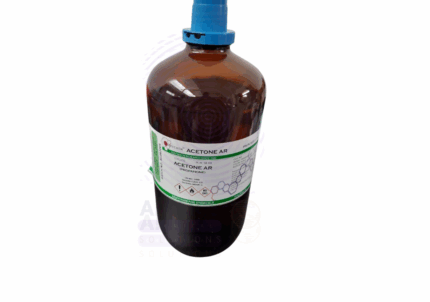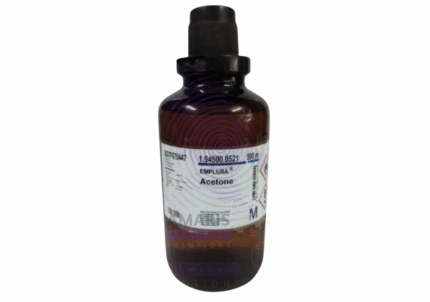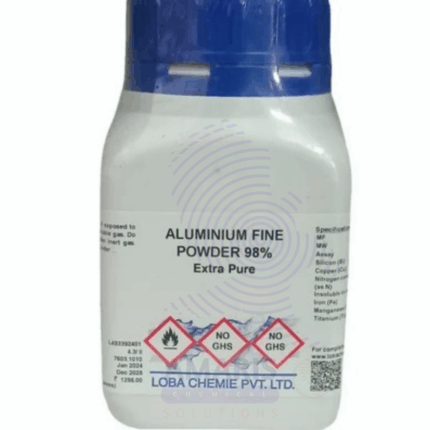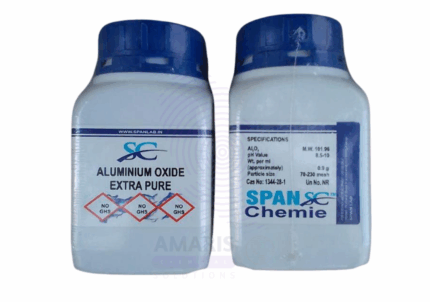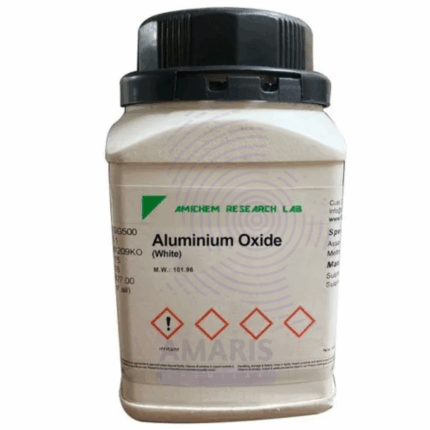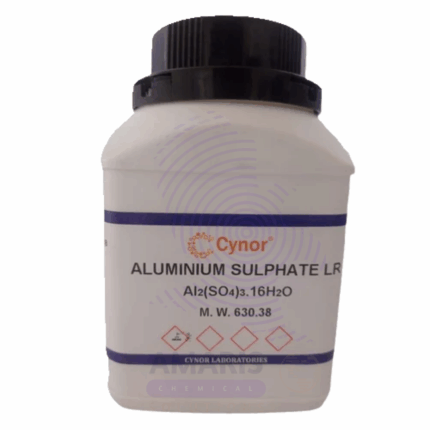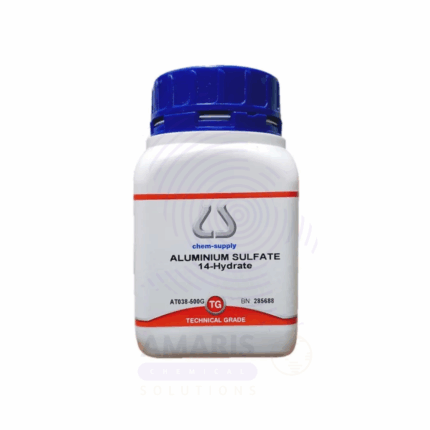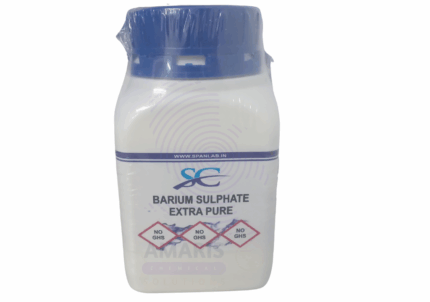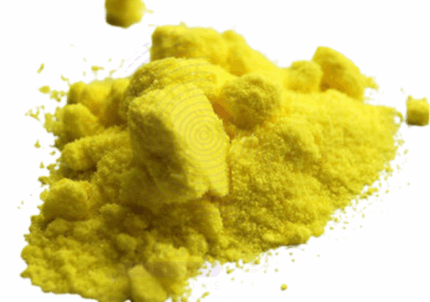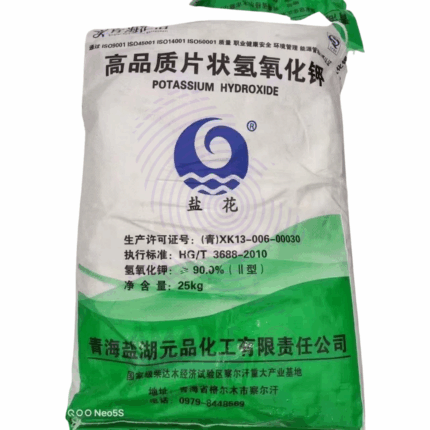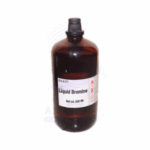
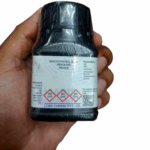
Bromine Water Extra Pure
$ 19.00 Original price was: $ 19.00.$ 18.00Current price is: $ 18.00.
Bromine Water Extra Pure is a highly purified aqueous solution of bromine, commonly used in laboratory settings for qualitative analysis, halogenation reactions, and redox studies. It acts as a powerful oxidizing and electrophilic brominating agent, making it ideal for detecting unsaturation in organic compounds—such as alkenes and alkynes—through decolorization tests. In inorganic chemistry, it is utilized for oxidation of specific ions and elements in solution. The extra pure grade ensures low contamination and consistent bromine concentration, crucial for reproducible analytical results. It should be stored in amber, airtight containers in a cool, well-ventilated area, and handled with proper protective equipment due to its corrosive and volatile nature.
Bromine Water Extra Pure
Primary Uses
- Test for Unsaturation in Organic Compounds
- Bromine water decolorizes in the presence of alkenes or alkynes, indicating the presence of C=C or C≡C bonds—a classic qualitative test in organic labs.
- Phenol and Aromatic Compound Testing
- Used to detect phenols and other electron-rich aromatic compounds through bromination reactions that form white precipitates (e.g., 2,4,6-tribromophenol).
- Mild Oxidizing Agent in Redox Reactions
- Acts as a moderate oxidizer for studying redox behavior in inorganic and general chemistry labs.
Secondary Uses
- Demonstrating Halogen Reactivity
- Common in teaching labs to demonstrate halogen displacement reactions and reactivity trends across Group 17 elements.
- Colorimetry and Reaction Rate Studies
- Used in kinetic experiments to observe rate of decolorization with different substances—excellent for reaction rate studies in physical chemistry.
- Preparation of Brominated Derivatives
- Sometimes used as a reagent source of Br₂ in gentle bromination reactions or derivative formation for structure elucidation.
| PACK SIZE |
1 Litre Glass bottle |
|---|
1. Basic Identification Attributes
- Chemical Name: Bromine Water
- CAS Number: 7726-95-6 (Bromine), 7732-18-5 (Water)
- HS Code: 2811.19.00
- Molecular Formula: Br₂ in H₂O (typically 0.1–5% Br₂ w/v)
- Molecular Weight (approx.): Variable depending on concentration
- Synonyms: Aqueous bromine solution, Bromine in water
- Grade: Extra Pure (for analytical and laboratory reagent use)
2. Physical & Chemical Properties
- Physical State: Liquid
- Color & Odor: Yellow to reddish-brown, with a strong chlorine-like or acrid odor
- Boiling Point: Approx. 100 °C (depends on water content)
- Density: ~1.0–1.2 g/cm³
- Solubility: Completely soluble in water; also dissolves slightly in organic solvents
- pH: Acidic (due to hydrolysis of bromine)
- Stability: Decomposes in light and on standing (must be freshly prepared for sensitive analysis)
3. Safety & Hazard Attributes
- GHS Classification:
- Corrosive to skin and eyes – Category 1
- Acute toxicity (inhalation and dermal) – Category 3
- Aquatic acute hazard – Category 1
- GHS Pictograms: ☣️ ⚠️ 🌊
- NFPA Ratings:
- Health: 3
- Flammability: 0
- Reactivity: 2
- Health Hazards:
- Causes skin burns and eye damage
- Harmful if inhaled; vapors may cause respiratory distress
- Protective Measures:
- Use fume hood, safety goggles, gloves (nitrile or butyl), and lab coat
4. Storage & Handling Attributes
- Storage Conditions:
- Store in amber glass containers, tightly sealed
- Protect from light and heat; refrigeration recommended for extended stability
- Incompatible Materials:
- Organic materials, strong bases, reducing agents, metals
- Packaging: Amber bottles with chemical-resistant caps
- Handling Precautions:
- Always handle in well-ventilated fume hoods
- Do not inhale vapors or allow contact with skin
5. Regulatory & Compliance Attributes
- Regulatory Status:
- Listed on TSCA, REACH, and other international inventories
- Transport Classification:
- May not be regulated at very low concentrations
- For concentrated solutions:
- UN Number: 1744
- Hazard Class: 8 (Corrosive), 6.1 (Toxic)
- Packing Group: I
- Waste Disposal:
- Neutralize with sodium thiosulfate before disposal
- Dispose of in accordance with institutional and local regulations
6. Environmental & Health Impact
- Ecotoxicity:
- Highly toxic to aquatic organisms even at low concentrations
- Degradability:
- Reacts and breaks down quickly in water and light
- Bioaccumulation:
- Does not bioaccumulate, but its byproducts may be harmful
- Health Effects:
- Can cause long-term damage to respiratory tissue if repeatedly exposed
SAFETY PRECAUTIONS
- Personal Protective Equipment (PPE):
- Use chemical splash goggles, face shield, nitrile or neoprene gloves, and a chemical-resistant lab coat.
- Always handle in a fume hood to avoid inhaling vapors.
- Handling:
- Do not inhale the vapors — bromine is highly irritating and corrosive.
- Avoid all contact with skin and eyes.
- Handle containers carefully and slowly, keeping tightly closed when not in use.
- Storage:
- Store in light-resistant glass containers, tightly sealed, in a cool, well-ventilated area.
- Keep away from organic materials, alkalis, and metals.
- Segregate from flammable and reactive chemicals.
- Incompatibilities:
- Reacts violently with ammonia, alkalis, and organic matter.
FIRST AID MEASURES
- Inhalation:
- Move to fresh air immediately.
- If breathing is difficult, administer oxygen.
- Seek urgent medical attention — bromine vapors are toxic to the lungs.
- Skin Contact:
- Remove contaminated clothing.
- Rinse affected skin with plenty of water for at least 15 minutes.
- Get medical attention immediately.
- Eye Contact:
- Flush eyes with water for 15 minutes, lifting eyelids.
- Seek emergency ophthalmic care — bromine can cause severe eye damage.
- Ingestion:
- Do not induce vomiting.
- Rinse mouth if conscious and give water.
- Get emergency medical help — ingestion can be fatal.
FIRE FIGHTING MEASURES
- Flammability:
- Bromine water is not flammable, but it can support combustion of other materials.
- Extinguishing Media:
- Use dry chemical, carbon dioxide, or foam to extinguish surrounding fires.
- Hazardous Combustion Products:
- Releases toxic hydrogen bromide (HBr) and bromine vapors when heated.
- Firefighting Equipment:
- Use self-contained breathing apparatus (SCBA) and full protective gear.
- Approach with caution — vapors are corrosive and toxic.


 Preservatives(food)
Preservatives(food) Flavor Enhancers
Flavor Enhancers Acidulants
Acidulants Sweeteners
Sweeteners Antioxidants
Antioxidants Colorants(food)
Colorants(food) Nutraceutical Ingredients (food)
Nutraceutical Ingredients (food) Nutrient Supplements
Nutrient Supplements Emulsifiers
Emulsifiers
 Collectors
Collectors Dust Suppressants
Dust Suppressants Explosives and Blasting Agents
Explosives and Blasting Agents Flocculants and Coagulants
Flocculants and Coagulants Frothers
Frothers Leaching Agents
Leaching Agents pH Modifiers
pH Modifiers Precious Metal Extraction Agents
Precious Metal Extraction Agents
 Antioxidants(plastic)
Antioxidants(plastic) Colorants (Pigments, Dyes)
Colorants (Pigments, Dyes) Fillers and Reinforcements
Fillers and Reinforcements Flame Retardants
Flame Retardants Monomers
Monomers Plasticizers
Plasticizers Polymerization Initiators
Polymerization Initiators Stabilizers (UV, Heat)
Stabilizers (UV, Heat)
 Antifoaming Agents
Antifoaming Agents Chelating Agents
Chelating Agents Coagulants and Flocculants
Coagulants and Flocculants Corrosion Inhibitors
Corrosion Inhibitors Disinfectants and Biocides
Disinfectants and Biocides Oxidizing Agents
Oxidizing Agents pH Adjusters
pH Adjusters Scale Inhibitors( water)
Scale Inhibitors( water)
 Antioxidants(cosmetic)
Antioxidants(cosmetic) Emollients
Emollients Fragrances and Essential Oils
Fragrances and Essential Oils Humectants
Humectants Preservatives
Preservatives Surfactants(cosmetic)
Surfactants(cosmetic) Thickeners
Thickeners UV Filters
UV Filters
 Fertilizers
Fertilizers Soil Conditioners
Soil Conditioners Plant Growth Regulators
Plant Growth Regulators Animal Feed Additives
Animal Feed Additives Biostimulants
Biostimulants Pesticides (Herbicides, Insecticides, Fungicides)
Pesticides (Herbicides, Insecticides, Fungicides)
 Active Pharmaceutical Ingredients (APIs)
Active Pharmaceutical Ingredients (APIs) Excipients
Excipients Solvents(pharmaceutical)
Solvents(pharmaceutical) Antibiotics
Antibiotics Antiseptics and Disinfectants
Antiseptics and Disinfectants Vaccine Adjuvants
Vaccine Adjuvants Nutraceutical Ingredients (pharmaceutical)
Nutraceutical Ingredients (pharmaceutical) Analgesics & Antipyretics
Analgesics & Antipyretics
 Analytical Reagents
Analytical Reagents Solvents(lab)
Solvents(lab) Chromatography Chemicals
Chromatography Chemicals Spectroscopy Reagents
Spectroscopy Reagents microbiology-and-cell-culture-reagents
microbiology-and-cell-culture-reagents Molecular Biology Reagents
Molecular Biology Reagents Biochemical Reagents
Biochemical Reagents Inorganic and Organic Standards
Inorganic and Organic Standards Laboratory Safety Chemicals
Laboratory Safety Chemicals Specialty Laboratory Chemicals(Special Laboratory Equipment)
Specialty Laboratory Chemicals(Special Laboratory Equipment)
 Demulsifiers
Demulsifiers Hydraulic Fracturing Fluids
Hydraulic Fracturing Fluids Scale Inhibitors(oil)
Scale Inhibitors(oil) Surfactants(oil)
Surfactants(oil) Drilling Fluids
Drilling Fluids
 Dyes and Pigments
Dyes and Pigments Bleaching Agents
Bleaching Agents Softening Agents
Softening Agents Finishing Agents
Finishing Agents Antistatic Agents
Antistatic Agents
 Admixtures
Admixtures Waterproofing Agents
Waterproofing Agents Sealants and Adhesives
Sealants and Adhesives Curing Compounds
Curing Compounds Concrete Repair Chemicals
Concrete Repair Chemicals Anti-Corrosion Coatings
Anti-Corrosion Coatings
 Surfactants(cleaning)
Surfactants(cleaning) Builders
Builders Enzymes
Enzymes Solvents (Cleaning)
Solvents (Cleaning) Fragrances
Fragrances
 Electronic Chemicals
Electronic Chemicals Catalysts
Catalysts Lubricants
Lubricants Photographic Chemicals
Photographic Chemicals Refrigerants
Refrigerants Automotive chemicals
Automotive chemicals Pyrotechnic Chemicals
Pyrotechnic Chemicals
 Biodegradable Surfactants
Biodegradable Surfactants Bio-based Solvents
Bio-based Solvents Renewable Polymers
Renewable Polymers Carbon Capture Chemicals
Carbon Capture Chemicals Wastewater Treatment Chemicals
Wastewater Treatment Chemicals
 Pigments
Pigments Solvents(paint)
Solvents(paint) Specialty Coatings
Specialty Coatings Binders/Resins
Binders/Resins Additives
Additives Driers
Driers Anti-Corrosion Agents
Anti-Corrosion Agents Functional Coatings
Functional Coatings Application-Specific Coatings
Application-Specific Coatings
 Fresh Herbs
Fresh Herbs Ground Spices
Ground Spices Whole Spices
Whole Spices Spice Blends
Spice Blends Dried Herbs
Dried Herbs
 Leavening Agents
Leavening Agents Dough Conditioners
Dough Conditioners Flour Treatments
Flour Treatments Fat Replacers
Fat Replacers Decoratives
Decoratives Preservatives(baking)
Preservatives(baking)
 Plasticizers & Softeners
Plasticizers & Softeners Reinforcing Agents
Reinforcing Agents Adhesion Promoters
Adhesion Promoters Vulcanizing Agents
Vulcanizing Agents Antidegradants
Antidegradants Blowing Agents
Blowing Agents Fillers & Extenders
Fillers & Extenders Accelerators & Retarders
Accelerators & Retarders

